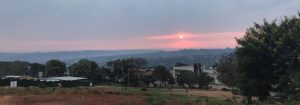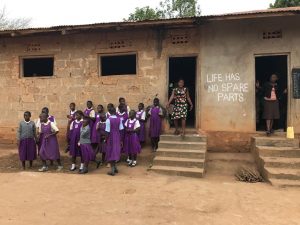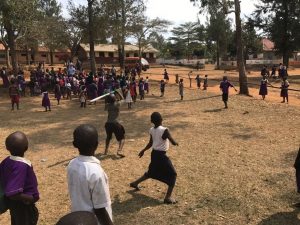As the first guest blogger for the trip I need to give a huge thanks to Lisa, Remmy, Angel, Mathias and the Kain Foundation for organising what has already been a trip of a lifetime. With less than half of the time passed, I can only imagine what’s to come!
A change in perspective was one of the few expectations I had as I boarded the flight a few days ago, and three full touring days in, we have this in spades.
We woke up today in Masaka, a town of 60,000 people after a great night of pork and conversation with Landcare at a local Pork Joint (BBQ pork sold by the kilo) that was an easy walk next door (read 3.5km hike with some of us needing bathroom stops).
There are a few of us who have taken to jogging around the local community in the mornings and running around Masaka was a dream compared to Kampala. Limited traffic, less (but still a lot) of hills and clean air for the lungs! The sunrise was amazing over the town (see pic below).

After breakfast we headed to Kaboyo Primary School where, as always, we were very warmly greeted by the teachers, the children and the community. This school focused on educating and improving farming practices in the region with the Kain Foundation and Landcare providing support.
My day job is in private equity, where winning the hearts and minds of the stakeholders for any investment is one of the most critical elements of success. By this measure and many others, the Kain Foundation, together with Landcare, have achieved enormous success in just 1 year of the program being operational at this school. The pride that everyone had in their school and the sincere thanks that was given by the teachers as well as the community shows that not only has the program been successful, but it will assist in the development of sustainable, efficient and productive farming practices (as well as supplying infrastructure such as water tanks) that are enriching the communities and assisting in their development for many years to come.
There are 5,000 families connected to this school community and the supply of trees cannot meet the demand. As principal James outlined to the group, they are transforming the community from job seekers to job creators and are well on the way of changing the attitudes of people in order to change and improve habits and farming techniques. In short, this program is working and transforming lives. You only have to spend 5 minutes talking to the locals to understand what an impact it is having.

So far on our travels each day generally has some very high highs but the underlying challenges of the communities also take an emotional toll.
The highs include mostly the joy of the kids, the pride of the parents in their Sunday best, the warm greetings and just feeling the energy that sits within the school. These visits are as exceptionally uplifting as they are exhausting. The greeting by the Kaboyo school involved some amazing dancing (almost matched by the team), followed by speeches, tree planting and play time with the kids. In these interactions, taking the language and setting aside, you could be at any school in Australia, everyone is happy.
However, not far beneath the surface lies some significant challenges. You have some understanding of these issues prior to visiting, but it smacks you in the face when you’re here. I mentioned perspective at the start of this post, and my daily challenges in “real life” in Australia belong to a different hierarchy of needs. We live in different worlds. My two year old in Brisbane will never have to experience a heightened fear of:
- Unclean drinking water – As mentioned by Lisa in previous posts, often the wells break down and the only access to water is through algae infested waters
- HIV – of the ~550 students, roughly half are infected with HIV. Half! This is not an issue that is under control, many of them children are orphaned and living at the school.
- Hunger – I have not witnesses malnourished children on this trip but judging by plate size proportions when we are having community lunches and the speed at which the kids run toward porridge at meal time, this is still a key factor in daily life;
- Waterproof shelter – the schools are in old and open aired mud brick buildings and much of the community housing has exposure to the elements. I can only imagine what it is like in monsoon.
Despite the above, these kids are just like my daughter and other kids in Australia. They love to play, sing, high five, just generally be in your company and ask great questions (“does your tribe have a chairperson”… or… “do you have problems with thieves in Australia”). It melts your heart.
It’s been an incredible experience so far and a huge thanks again to the Kain Foundation for the amazing work they are doing and to BlueSky who sponsored me on this trip.

Warm regards,
Nick
